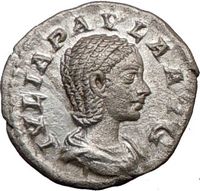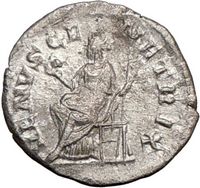Julia Paula Elagabalus wife Roman Empress 219-220AD Ancient Numismatic
Coins for Sale & Investment
Own certified authentic ancient Roman coins of Julia Paula Elagabalus,
You can explore a selection of other emperor and empress coins by
visiting the chronological list of every emperor and empress of the
Roman empire. Ancient coins make a great gift, investment and a teaching
aid to learning history. It is important to deal with trusted coin
dealers, that is why this is the best place for you to shop online.
You can also watch the video below for more info
 
Authentic Ancient Coin of:
Julia Paula - Roman Empress & First wife of Emperor
Elagabalus -
Silver Denarius Antioch mint: 219-220 A.D.
Reference: RIC 222 note
IVLIA PAVLA AVG, draped bust of Julia Paula right.
VENVS GENETRIX, Venus Genetrix enthroned left, holding globe and
grounded scepter.
Venus
was a
Roman
goddess principally associated with
love,
beauty and
fertility, who played a key role in
many
Roman religious festivals and myths.
From the third century BC, the increasing
Hellenization of Roman upper classes
identified her as the equivalent of the
Greek goddess
Aphrodite.
.jpg/350px-La_nascita_di_Venere_(Botticelli).jpg)
The Birth of Venus, by
Sandro Botticelli c. 1485–1486.
Her cult began in
Ardea and
Lavinium,
Latium. On August 15, 293 BC, her
oldest known
temple was dedicated, and August 18
became a festival called the
Vinalia Rustica. After
Rome's
defeat at the
Battle of Lake Trasimene in the opening
episodes of the
Second Punic War, the Sibylline oracle
recommended the importation of the Sicillian Venus of Eryx; a temple to
her was dedicated on the
Capitoline Hill in 217 BC: a second
temple to her was dedicated in 181 BC.
Venus seems to have played a part in household or private religion of
some Romans. Julius Caesar claimed her as an ancestor (Venus Genetrix);
possibly a long-standing family tradition, certainly one adopted as such
by his heir
Augustus. Venus statuettes have been
found in quite ordinary household shrines (lararia). In fiction,
Petronius places one among the
Lares
of the
freedman
Trimalchio's household shrine.
Julia Cornelia Paula or Julia Paula was
a distinguished, Roman noble woman who lived in the 3rd century. Paula
was a member of the
Cornelius (gens) of ancient Rome. She
was a Syrian woman of Roman descent and her family was a distinguished
family from
Syria. Paula’s father, Julius Cornelius
Paulus was a prefect of the
Praetorian Guard in
Rome; however, his ancestry is not
known. Paula was well educated and was a charming person.
In 219,
Julia Maesa (eldest sister of Roman
Empress
Julia Domna), had arranged for Julia
Cornelia Paula to marry her grandson, Rome’s new emperor
Elagabalus. Their wedding ceremony was
a lavish ceremony that occurred in Rome. Paula became a Roman empress,
as Elagabalus’ first wife and was given the honorific title of
Augusta.
In early 220, Elagabalus ended his marriage to Paula.
They had no children. Elagabalus divorced Paula to marry the
Vestal Virgin Julia
Aquilia Severa. His marriage to Severa
was considered as scandalous because she was still a Vestal. Apart from
falling in love with Severa, Elagabalus married Severa as apart of the
religious process of worshipping the Syrian Sun God El-Gabal and
integrating El-Gabal into Roman religion.
After the divorce, Elagabalus removed Paula's Augusta
title. She withdrew from public life and her fate afterwards is unknown.
|